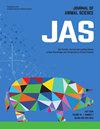48 Red clover leaf can partially attenuate fescue toxicosis-related heat stress in cattle
IF 2.7
2区 农林科学
Q1 AGRICULTURE, DAIRY & ANIMAL SCIENCE
引用次数: 0
Abstract
Ergot alkaloids in endophyte-infected tall fescue (E+TF) can negatively impact the welfare and growth of cattle by altering the physiology of the animal including systemic vasoconstriction resulting in decreased capacity for thermoregulation and increased heat stress susceptibility. The isoflavones in legumes, specifically red clover (RC), are known hypotensive agents and can be used to prevent vasoconstriction associated with E+TF. Based on the vasodilatory properties of RC, the objective of this study was to determine if low levels of RC could also prevent fescue toxicosis-related heat stress (HS). We hypothesized that cattle receiving E+TF seed with RC will have reduced rectal temperature (RT) and respiration rates (RR) in comparison to those that receive isoflavone-free orchardgrass (OG) when subjected to a HS challenge. Two blocks of 6 ruminally-fistulated beef-cross steers (Initial body weight (BW), block 1: 521.0±9.1kg and block 2: 360.8±11.6kg) were dosed intraruminally with E+TF seed (15 µg kg BW-1 ergovaline + ergovalanine) daily, and stratified by BW into 2 treatments of either 25 g head d-1 ground [5 mm] OG (E+OG) or RC leaf (E+RC). All steers were first adapted to their basal diet (ad libitum corn silage + dried distillers’ grains with solubles) for 14-d and then were subjected to treatments for 14-d including a 7-d thermoneutral period (TN: 21.0˚C, 64.0% humidity, Temperature-Humidity Index (THI)=67) followed by a 7-d HS challenge period (cyclical daily temperatures to mimic diurnal patterns; HS: 23.2˚C–33.6˚C, 39.5–70.0% humidity, THI=70.3–83.5). At 0630, 1230, and 1730-h each day, RR and RT were measured by counting flank movements for 15 s and using a rectal thermometer, respectively. Data were analyzed using the MIXED procedure with repeated measures of SAS (v.9.4) with significance observed at P ≤ 0.05. At the end of the adaptation period (no treatments), RR was 50±1.4 breaths·min-1 and RT was 38.6±0.05 ˚C on average. By days 5 and 7 of the thermoneutral period E+OG steers had greater RT (+0.5˚C) and RR (+11 breaths·min-1) in comparison with E+RC steers, regardless of sampling time, respectively (P < 0.05). During the HS challenge, RT and RR continued to increase in E+OG steers from day 8 to day 12 (day 13 for RR 0630-h) peaking at 40.1˚C and 121 breaths·min-1 at 0630, 40.3˚C and 143 breaths·min-1 at 1230, and 40.6˚C and 161 breaths·min-1 at 1730-h (P < 0.01). Rectal temperature and RR also increased in E+RC steers during HS period, peaking on days 12 and 13 (0630-h: 39.2˚C, 85 breaths·min-1; 1230-h: 39.5˚C, 106 breaths·min-1; 1730-h:39.4˚C, 109 breaths·min-1); however, on all days and sample times, RR and RT were lower in E+RC compared to E+OG steers (P < 0.05). Results of the current study indicate that a small amount of RC daily can partially attenuate fescue toxicosis-related heat stress.48红三叶草叶可以部分减轻羊茅中毒引起的牛热应激
内生菌感染的高羊茅(E+TF)中的麦角生物碱可以通过改变动物的生理机能,包括全身血管收缩,导致体温调节能力下降和热应激易感性增加,对牛的福利和生长产生负面影响。豆科植物中的异黄酮,特别是红三叶草(RC),是已知的降压剂,可用于预防与E+TF相关的血管收缩。基于RC的血管扩张特性,本研究的目的是确定低水平RC是否也可以预防羊茅中毒相关热应激(HS)。我们假设,与那些接受不含异黄酮的果园草(OG)的牛相比,接受含有RC的E+TF种子的牛在受到HS挑战时,其直肠温度(RT)和呼吸速率(RR)会降低。2组6头瘤胃管型杂交牛(初始体重为52.1±9.6 kg,第1组为521.0±9.6 kg,第2组为360.8±11.6kg)每天腹腔内注射E+TF种子(15µg kg BW-1麦角缬氨酸+麦角缬氨酸),并按体重分为2组,分别为25 g头d-1磨碎[5 mm] OG (E+OG)或RC叶(E+RC)。所有阉牛先适应基础饲粮(自由采食玉米青贮+干酒糟及可溶物)14 d,然后进行7 d热中性期(TN: 21.0℃,湿度64.0%,温湿度指数(THI)=67)和7 d高温刺激期(循环日温模拟日模式;海关:23.2˚C - 33.6˚C, 39.5 - -70.0%的湿度,THI = 70.3 - -83.5)。每天06:30、1230和1730 h,分别用直肠体温计和计数腹部运动15 s来测量RR和RT。数据分析采用MIXED程序,重复测量SAS (v.9.4), P≤0.05为显著性。适应期结束时(未处理),RR平均为50±1.4次呼吸·min-1, RT平均为38.6±0.05˚C。在热中性期的第5天和第7天,无论采样时间如何,E+OG组的RT(+0.5˚C)和RR(+11次呼吸·min-1)分别高于E+RC组(P <;0.05)。在HS挑战期间,E+OG舵手的RT和RR从第8天到第12天(RR为0630-h的第13天)继续增加,在0630时达到40.1˚C和121呼吸·min-1,在1230时达到40.3˚C和143呼吸·min-1,在1730-h时达到40.6˚C和161呼吸·min-1 (P <;0.01)。在HS期间,E+RC组的直肠温度和RR也有所升高,在第12天和第13天达到峰值(0630-h: 39.2˚C, 85次呼吸·min-1;1230-h: 39.5˚C, 106次呼吸·min-1;1730-h:39.4˚C, 109次呼吸·min-1);然而,在所有的日子和采样时间里,E+RC组的RR和RT都低于E+OG组(P <;0.05)。本研究结果表明,每天少量的RC可以部分减轻羊茅中毒相关的热应激。
本文章由计算机程序翻译,如有差异,请以英文原文为准。
求助全文
约1分钟内获得全文
求助全文
来源期刊

Journal of animal science
农林科学-奶制品与动物科学
CiteScore
4.80
自引率
12.10%
发文量
1589
审稿时长
3 months
期刊介绍:
The Journal of Animal Science (JAS) is the premier journal for animal science and serves as the leading source of new knowledge and perspective in this area. JAS publishes more than 500 fully reviewed research articles, invited reviews, technical notes, and letters to the editor each year.
Articles published in JAS encompass a broad range of research topics in animal production and fundamental aspects of genetics, nutrition, physiology, and preparation and utilization of animal products. Articles typically report research with beef cattle, companion animals, goats, horses, pigs, and sheep; however, studies involving other farm animals, aquatic and wildlife species, and laboratory animal species that address fundamental questions related to livestock and companion animal biology will be considered for publication.
 求助内容:
求助内容: 应助结果提醒方式:
应助结果提醒方式:


